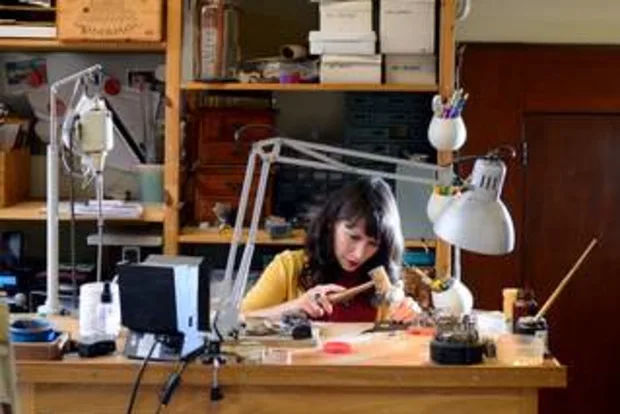Designing jewellery is an art – a unique and exciting art. But earlier this art was confined to select few artisans (kaarigars) and handed down generation to generation.
With the recent boom and opening up of the branded market, jewel design is flourishing like never before. It is no longer restricted to designing traditional gold and diamond pieces either and is a flourished industry now.
It offers immense opportunities for exclusive, contemporary, stylised and designer jewellery in keeping with latest fashion trends.
But the job doesn’t end with designing. Jewellery artists also have to be involved hands-on in the actual manufacturing process where craftsmen use specialised hand tools and equipments to turn the designs into exquisite, flawless pieces!
Katheryn Leopoldseder, anAustralian born contemporary jeweller, artist and designer has made a special place for herself in designing the contemporary jewellery. She is a Bachelor of Arts with Honours in Gold and Silver smithing from RMIT, Melbourne.
For several years she has been designing and making jewellery and artworks and has also exhibited her work both nationally and internationally.
In a recent interview Katheryn shares her insights with ‘Public Telegraph’ on designing jewellery for today’s woman, the state of fashion today, and a few things people might not know about her
Tell us something about yourself?
I am an Australia based jeweller, artist and designer who is fascinated towards the art of jewellery designing.
For several years I have been self employed, designing and making jewellery and artworks from my sun-lit studio within the historic Abbotsford Convent Arts and Cultural Precinct.
From here I design and handicraft unique jewellery for galleries around Australia.
I also conduct workshops on jewellery making and work with clients to make bespoke pieces. I really enjoy making one-off contemplative artworks that are exhibited both locally and internationally.
After recent tours to India, the first time with aid organization ‘Jacob’s well’ and second time as a delegate to ‘The World Craft Council’s Abhushan’ conference, the subject of my wearable artworks has turned to examining the common ground between Australian and Indian values.
How you got interested in Arts, and tell us something about your work?
Since my early childhood, I was interested in making things with my hands. When I was six or seven, I used to repair my gold chain by levering the links back together with scissors. When I was 10, I made beaded jewellery that I sold at market stalls. I used to carry an oversized fishing tackle box everywhere, packed full of tools and beads!
I think I’ve always been inspired by the concept of redemption. I believe that I can start with something simple, or discarded or seemingly worthless and by spending time with it, injecting it with vision and crafting it, it can be turned into something of value.
How it all started and who is your inspiration?
It is hard to say what my inspiration is, sometimes it’s the materials, sometimes exploring a process but mostly I am interested in people.
Jewellery is a very personal medium that takes on another life when someone wears it. It lends itself to talking about the human condition. I am particularly interested in the ideals we establish in our lives, both personally and as a society, and how we so often fall short of our own expectations of ourselves.
Share something about your exhibition ‘Where Moth and Rust Decay. From where this title is inspired and what motivated you to pick this title?
I visited India recently for my exhibition of contemporary jewellery entitled, ‘Where Moth & Rust Decay’.
The title comes from a scripture: “Do not store up for yourselves wealth here on earth, where moths and rust destroy, and burglars break in and steal. Instead store up for yourselves wealth in heaven, where neither moth nor rust destroys, and burglars do not break in. For where your wealth is, there your heart will be also.”
I found this scripture challenging in the context of being an Australian travelling through India. I observed in India a growing desire to embrace the consumer culture that characterises the West. From an Australian perspective, many of us feel unsatisfied by the vast difference between the security and fulfilment that this consumer culture appears to promise, and what it is actually able to deliver.
For many Australians, travelling to India represents an attempt to escape the endless cycle of purchasing and waste and the necessary disconnection from one another and the environment that comes from pursuing this lifestyle. This awkward relationship between the two countries idealised notions of one another’s lifestyle inspired this work.
Where Moth & Rust Decay examines the limitations of material wealth and the intangible desires that drive us to pursue symbols of status and security. The jewellery reflects on the mythological nature of consumerism. That it always keeps us in a state of desire and perceived lack.
What material you choose for your work?
The materials I have used for Where Moth & Rust Decay are diverse. They include traditionally precious materials like gold and silver, while I have also chosen unconventional ones like porcelain, silk and mild steel.
I choose materials that contribute meaning to the work. For example in my Trading Culture For Coke Bangle I have made most of the bangles from copper so that I could give it an aged patina, hoping to make it look like an ancient Indian artefact. But in place of where gems would usually be, there is Coke Cola can gleaming through.
The bangle references one of my first experiences in India. Arriving in Mumbai I was struck by an illuminated advertisement for Coke that read:
‘A mighty ocean we’re not. But we are the little drops that make one. Because small things go a long way. At Coca-Cola India, we believe that there’s more to a little sip. It’s the moment of truth. A second of satisfaction. An instant of happiness. A bubble of hope. Because we don’t just quench your thirst. We recharge your soul. For one moment. One drop at a time.Coca Cola India – little drops of joy.’
The day after being appalled by the blatant manipulation within this sign, while travelling with aid organization Jacob’s Well, I was invited to meet people living in the heart of Dharavi. In a gesture of hospitality, these warm people presented us with a bottle of Coke. I heard later that they had each contributed some of their precious money to buy us this welcome gift. The experience broke my heart.
As your work exquisitely transforms every day material items and suburban shrines into architectural adornments, from where you get all these ideas?
Within ‘Where Moth & Rust Decay’ I have tried to identify the places both cultures tend to put their sense of value.
I have found that we are all vulnerable towards putting a disproportionate sense of our value and hope into material possessions or the acquisition of them. In Australia for example, there is a very strong notion that feeling secure is about property ownership.
Tell us something about the ‘Suburban dream’?
This is a classic three-bedroom brick veneer house made into a ring. Loosely modelled off the floor plan of my husband’s grandmother’s house. A classic fifties brick veneer in Burwood. My representation of the house has open bricks that you can see through, giving it a sense of its not being as solid as you would think.
I have constructed it from hundreds of tiny bricks made from Sterling silver wire, while I have used corrugated rusty mild steel to make a typical Indian slum dwelling that collapses to be worn as a necklace.
The use of precious silver communicates a perception in society that one type of dwelling is more valued than the other. But together these two houses are displayed under a radiant golden sun, which is a brooch. Its title is All Under The Same Sun. All The Same Under The Sun.
I hope that this triptych would communicate a common humanity despite how different our lives may appear to one another.
How do you distil thoughts about values and culture in jewellery?
I distil my observations about personal values and culture into wearable artworks, by harnessing jewelleries rich relationship to the body, to history, to notions of preciousness, to personal and cultural identity and to desire.
Often meaning is created by which part of the body the jewellery is located on.
How you find jewellery an important medium for expression of ideas and emotions?
Jewellery is on a human scale. It is portable and takes on meaning beyond that imbued by its maker, through the life of its wearer. It can convey identity or help to construct how we wish to be perceived.
As you have travelled to India, so share some of your experiences about that country?
India has challenged me in many ways. In my first trip where I travelled with an aid organization I spent a lot of time with the desperately poor.
Like many before me I was shocked by the scale of poverty there. But gradually India taught me that as humans we are all the same. Our living standards might be different but we share the same fundamental components that make us human, emotions, joy, fear, hope, grief and desire for a sense of belonging.
Do you come across any difficulties while in India?
Yes of course, soon after reaching India, I suffered from Dengue and was hospitalised for few days.
Despite this India has taught me how to trust. The way things get organised there is quite different from home. For example, to organise an exhibition in Melbourne takes many months, perhaps you even book your venue a year in advance.
But in India, things seem to come together quite spontaneously. You quickly learn that just because things may not look like they are happening; it doesn’t mean they won’t come together when they need to.
How was the response of the exhibition in India?
I was thrilled to discover that the Indian audience is able to laugh at the ironies that my exhibition identified in its own behaviour perhaps even more readily than the Australian audience could laugh at their own.
Something else that I found interesting was that in India there seems a very clear distinction between the craftsperson and the designer. In Australia they are often one and the same. People found it quite unusual that I not only designed each artwork, I also handcrafted each from start to finish and in some cases made my own tooling in order to do so.
How this conference would help both the countries?
The Samaanata conference, of which my exhibition was a part, is a component of a three year series of exchanges between India and Australia.
This particular event focused on how to make the relationships between artisan, designer and consumer more equitable. It’s an ongoing discussion that will yield a Code of Practice for this relationship, as well as create international collaborations and inspiring models for exchange between these three parties.
It has gathered a really fascinating bunch of people from both Australia and India with terrific ideas. I look forward to seeing what projects unfold from it in the future!

